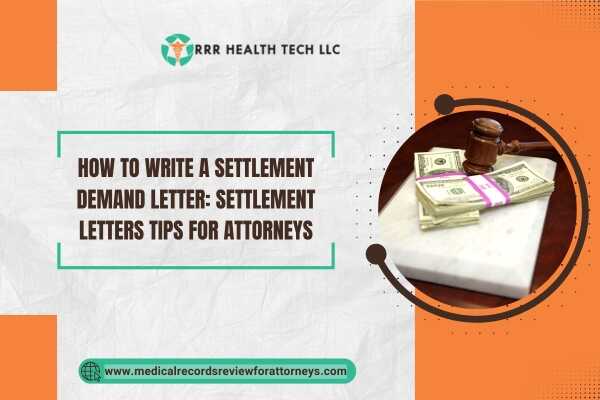
Introduction
In personal injury law, a particular letter that captures the negotiation of payment for services is demand for settlement letter. This document acts as the outline of the case and the basis of logic on why the amount sought should be paid. Let us discuss the details surrounding writing of Demand Letter, especially the role of legal medical record reviewers in America.
Importance of a Demand Letter for Settlement
What Is A Letter Of Demand For Settlement?
This is a letter drafted and sent to an opposing party or a case’s insurance provider cataloguing the case’s details and the amount to be paid alongside what is compensated for. This letter usually serves as the starting point of bargaining and if appropriately written, can assist the legal practitioner in winning the case towards negotiating a settlement.
Why Is This Letter Significant?
• Explains the Foundation of the Claim: It weaves a clear story of what happened, the injuries a person sustained and how they have affected their life statement.
• Sets the Tone for Negotiations: This document offers a brief structure of the case the lawyer possesses and thus can set a friendly atmosphere.
• Legal Documentation: Maintains a formal register of the claim that may be useful in any subsequent legal disputes.
Key Elements of a Settlement Demand Letter
Introduction
• Identify the Parties: Describe who is relevant to the claim.
• Purpose of the Letter: Provide the reason for writing the letter in concise terms.
Case Overview
• Incident Description: Describe the account of the incident in a chronological manner which leads to the claim.
• Injuries Sustained: Discuss the injuries, and how they affect the client’s day to day activities.
Review of Medical Records
• Importance of Medical Records: Illustrate the way medical records help the claim.
• The Role of Medical Records Review Companies: Discuss how these businesses aid lawyers in proving their clients’ cases by pulling together necessary medical documentation through their frameworks.
Damages
• Economic Damages: Discuss medical bills, income that cannot be earned along with other financial losses.
• No-Economic Damages: Describe suffering, stress, and loss of pleasure in life.
Settlement Demand:
• Specified Amount Requested: Indicate the compensation sought from the claim and the amount.
• Justification for the Amount: Explain the reasoning for the given amount against evidence provided just before.
Common Pitfalls to Avoid
• Vagueness: Avoid ambiguity regarding the details of the claim.
• Excessive Colloquialisms: For the sake of safety for constructive dialogue, keep a professional tone.
• Lack of Proof: Back every claim with adequate proof such as medical documents.
How Medical Records Review Companies Enhance Settlement Demand Letters
Improving Workflow
Medical record review companies focuses on the evaluation and summarization of relevant medical documents. Because of this, the attorney can tell a clear and compelling story in almost all of his settlement demand letters.
Comprehensiveness and Accuracy
Doctors and attorneys make use of medical record review services so that all pertinent documents are present and all relevant medical information is added to the file without missing crucial parts that can make or break the case.
Case Study
Case Study 1: The Smith Family Case
Overview: The mother of the Smith family got involved in a horrendous car accident where she sustained severe injurious wounds requiring complex medical treatment from a doctor.
Challenges: The insurance company presented an offer that was significantly less than the family’s medical bills and lost income in the form of wages.
Solutions: An attorney involved a medical record review company to prepare the mother’s medical records as the primary piece of evidence showcasing her life-changing surgical injuries and treatment post the accident.
Compensation: The attorney successfully negotiated to get all medical expenses covered along with pain and suffering compensation thanks to the overwhelming evidence.
Case Study 2: The Johnson Case
Overview of the Case: In a grocery store, Mr Johnson had a slip and fall accident that resulted in a wrist fracture, necessitating surgery.
Challenges: The supporting evidence of medical treatment was inadequate for non-economic damages, which made justifying the claim challenging.
Solutions: The lawyer engaged with a medical records review firm and ensured that the summary crafted regarding Mr Johnson’s medical treatment was holistic and multidisciplinary.
Compensation: The more persuasive demand letter greatly heightened the settlement, offering to cover all medical expenses and compensation for disturbance.
Current Trends in Settlement Demand Letters (2024)
Growing Use of Technology
With the constant improvement of technology, it has become easier for attorneys to draft and send letters digitally. This shift improves efficiency and helps track communications.
Focus on Personalization
Personalization in people’s letters has become more prevalent and appreciated. Addressing distinct details of the letter’s focal point increases the chance of favourable responses.
An Increase in Comprehensive Evidence
The Addition of Medical Records, Expert Opinions, and Witness Statements have become more emphasized in attorneys’ demand letters to reinforce the provided records and strengthen the claim.
Value-Added Suggestions for Law Professionals
• Consider Medical Records Review Services: An alliance with a medical records review service can improve the quality as well as the demand letters that you generate.
• Pay Attention to Legal Developments: Make sure to check recent personal injury law updates, as well as other changes to settlement negotiation techniques.
• Implement Digital Solutions: Use software to prepare, issue, and monitor demand letters for smooth interactions and better time management.
Conclusion
A well-prepared letter of demand for settlement is vital for any lawyer who has a client suffering from an injury. Where a medical records review is completed accurately, and other processes are followed, favourable settlement outcomes tend to improve for attorneys.
